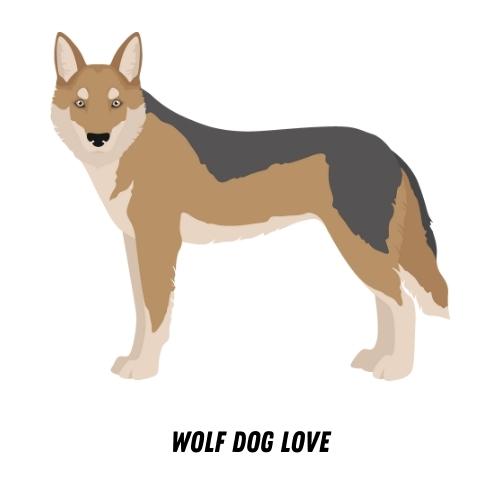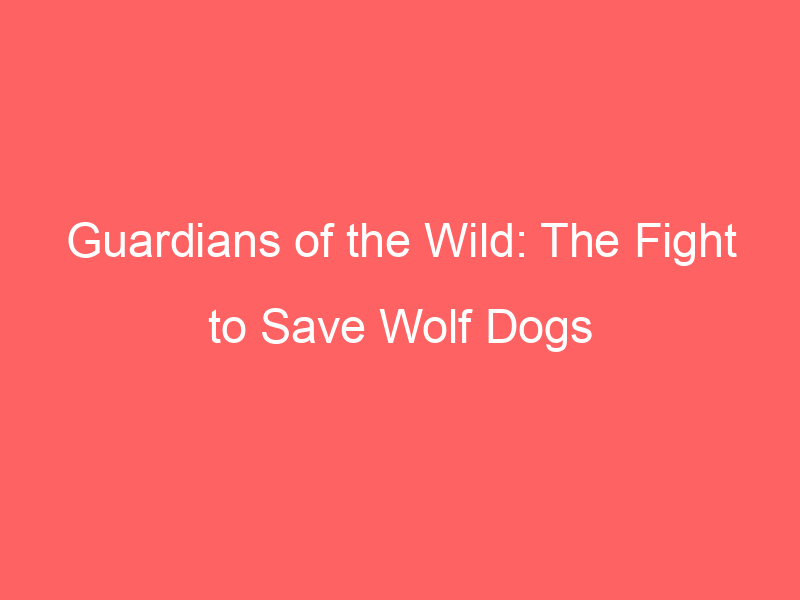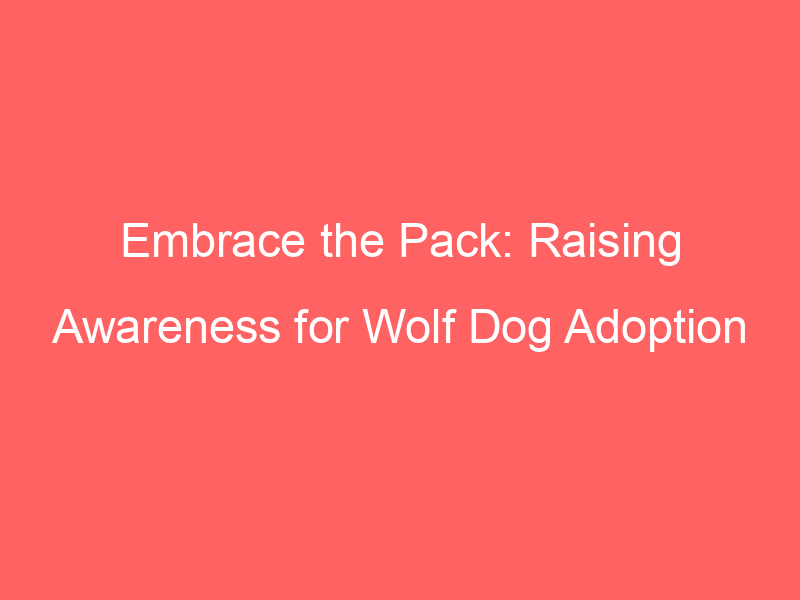Introduction to Wolf Dog Conservation
Wolf dogs, a unique blend of domestic dog and wild wolf, are fascinating creatures that hold a special place in our ecosystem. However, they are facing significant threats, making their conservation a crucial topic. This section will provide an introduction to the importance of wolf dog conservation and the current state of this species.
- Understanding the Importance of Wolf Dog Conservation
- Current State of Wolf Dog Species
Wolf dogs are not just beautiful creatures; they play a vital role in maintaining the balance of our ecosystem. They are natural predators, helping to control the population of other animals and thus preserving the biodiversity of their habitats. Unfortunately, due to factors like habitat loss, hunting, and disease, their numbers are dwindling. This is why understanding and supporting wolf dog conservation efforts is so important.
Currently, wolf dogs are facing a critical situation. Their population has been declining at an alarming rate. According to recent studies, the number of wolf dogs in the wild is at its lowest in recorded history. This decline is primarily due to loss of habitat, hunting, and diseases. The situation is so dire that some wolf dog breeds are now considered endangered. This highlights the urgent need for effective conservation strategies to protect and preserve these magnificent animals.
In the following sections, we will delve deeper into the various efforts being made to preserve wolf dogs, the ways in which we can champion their protection, and the importance of preserving their habitats. We will also discuss the broader topic of animal conservation and the role each of us can play in preserving the wolf dog population. Stay tuned to learn more about the fight to save wolf dogs.
Preservation Efforts for Wolf Dogs
Wolf dogs, a unique blend of domestic dog and wild wolf, are intriguing creatures that require our attention and care. Preservation efforts for these animals are critical and are being carried out on a global scale. Let’s delve into the global efforts in wolf dog preservation.
Global Efforts in Wolf Dog Preservation
Across the globe, various organizations and governments are working tirelessly to ensure the survival and well-being of wolf dogs. These efforts are primarily focused on two fronts: international laws and regulations, and the role of wildlife organizations.
- International laws and regulations
- Role of wildlife organizations
International laws play a crucial role in the preservation of wolf dogs. These laws aim to protect these animals from illegal hunting and trading. For instance, the Convention on International Trade in Endangered Species of Wild Fauna and Flora (CITES) is an international agreement between governments. Its aim is to ensure that international trade in specimens of wild animals and plants does not threaten their survival. This includes wolf dogs, ensuring their protection on a global scale.
Wildlife organizations are another key player in the global preservation of wolf dogs. These organizations work to protect and conserve wolf dogs through various means, such as rescue operations, rehabilitation, and educational programs. For example, the International Wolf Center is a leading organization that promotes the survival of wolf populations by teaching about wolves, their relationship to wildlands, and the human role in their future. They carry out numerous programs to educate the public about wolf dogs and their importance in the ecosystem.
In conclusion, the global efforts in wolf dog preservation are significant and multi-faceted. They involve a combination of international laws and the tireless work of wildlife organizations. Together, these efforts aim to ensure the survival and well-being of wolf dogs, preserving them for future generations to appreciate and learn from.
National Efforts in Wolf Dog Preservation
Wolf dogs are a unique blend of domestic dog and wild wolf. Their preservation is a matter of national importance. Let’s take a closer look at the efforts made at the national level to protect and preserve these magnificent creatures.
- Government Policies and Initiatives
The government plays a crucial role in the preservation of wolf dogs. It is responsible for creating policies and initiatives that protect these animals and their habitats. For instance, the Endangered Species Act (ESA) is a powerful tool used by the government to protect species at risk, including wolf dogs. This act makes it illegal to harm, harass, or kill any listed species.
Another significant initiative is the establishment of protected areas. These are regions where wolf dogs can live without the threat of human interference. The government also funds research and conservation programs to study wolf dogs and find ways to improve their survival chances.
- Local Community Involvement
Local communities also play a vital role in wolf dog preservation. They are often the first line of defense against threats to these animals. Many communities have taken steps to educate their members about the importance of wolf dogs and how to coexist peacefully with them.
Community-led initiatives include volunteer programs, where locals help monitor wolf dog populations and report any threats. Some communities have also implemented recycling programs to reduce waste that can harm wolf dog habitats. Additionally, local schools often include conservation education in their curriculum to instill a love for nature and wildlife in the younger generation.
In conclusion, national efforts in wolf dog preservation involve a combination of government policies and local community involvement. Both play a crucial role in ensuring the survival of these unique and beautiful creatures.
Championing Wolf Dog Species Protection
Wolf dogs are a unique blend of the wild and the domestic, carrying the genes of both wolves and dogs. Their protection is a cause that many have taken up, with some key figures leading the way. Let’s explore who these individuals are and how they have contributed to the conservation of wolf dog species.
Key Figures in Wolf Dog Conservation
There are many people who have dedicated their lives to the protection and preservation of wolf dogs. Here are some of the most notable individuals and their contributions:
- Dr. Jane Goodall: Known for her work with primates, Dr. Goodall has also been a vocal advocate for wolf dogs. She has used her platform to raise awareness about the need for their protection and conservation.
- Jim and Jamie Dutcher: The Dutchers are filmmakers who have spent years living with and documenting the lives of wolf dogs. Their films have brought the plight of these animals to the attention of millions.
- Robert Ballard: Ballard is a biologist who has dedicated his career to studying and protecting wolf dogs. His research has been instrumental in shaping conservation strategies.
These individuals have made significant contributions to the cause, but they are not alone. There are many others out there working tirelessly to protect wolf dogs.
Now, let’s look at some successful conservation stories that have resulted from these efforts.
- Case Study: The Return of the Red Wolf: Once nearly extinct, the Red Wolf population has been slowly recovering thanks to conservation efforts. This is a testament to what can be achieved with dedication and hard work.
- Case Study: The Mexican Wolf Recovery Program: This program has been successful in reintroducing Mexican wolves into their natural habitat. It’s a shining example of how conservation can help restore a species.
These case studies show that with the right efforts and dedication, it is possible to protect and preserve the wolf dog species. It’s a cause that requires the support of everyone, from scientists and conservationists to everyday people who care about these magnificent creatures.
How to Become a Champion for Wolf Dog Conservation
Do you want to make a difference and help protect wolf dogs? Here’s how you can become a champion for wolf dog conservation. It’s not as hard as you might think!
- Steps to take for active involvement
- Resources for further education
Firstly, you need to educate yourself about wolf dogs. Learn about their habits, their needs, and the threats they face. You can do this by reading books, watching documentaries, or visiting websites dedicated to wolf dog conservation.
Next, spread the word. Share what you’ve learned with your friends, family, and community. You can do this through social media, school projects, or even by starting a wolf dog conservation club.
Finally, get involved with local conservation efforts. This could mean volunteering at a wolf dog rescue center, participating in a local clean-up day, or even adopting a wolf dog if you’re able.
There are many resources available for those who want to learn more about wolf dog conservation. Here are a few to get you started:
| Book | Description |
|---|---|
| “The Wolf Almanac” | This book provides a comprehensive look at wolves and their close relatives, wolf dogs. It covers everything from their history to their behavior and conservation efforts. |
| “Living with Wolves” | This book shares the experiences of two filmmakers who spent six years living with a pack of wolves. It offers a unique insight into the lives of these magnificent creatures. |
Remember, becoming a champion for wolf dog conservation is about more than just learning facts. It’s about taking action and making a difference. So, what are you waiting for? Start your journey today!
Wolf Dog Habitat Preservation
Preserving the habitats of wolf dogs is a crucial aspect of ensuring their survival. These unique animals require specific conditions to thrive, and their habitats are under constant threat. Let’s explore some of the major threats to wolf dog habitats.
Threats to Wolf Dog Habitats
Wolf dogs face a variety of threats that are causing significant damage to their habitats. The two primary threats are the impact of climate change and human encroachment and deforestation.
- Impact of Climate Change
- Human Encroachment and Deforestation
Climate change is a global issue that affects all life on Earth, including wolf dogs. Changes in temperature and precipitation patterns can alter the habitats of these animals, making them less suitable for their survival. For example, warmer temperatures can lead to the melting of snow, a crucial element of the wolf dog’s habitat. This can result in a decrease in the availability of prey and a reduction in the size of their territories.
Human activities, such as urban development and agriculture, are leading to the destruction of wolf dog habitats. Deforestation for timber and to clear land for farming is causing a significant loss of forest areas, the natural habitat of wolf dogs. This not only reduces the space available for these animals but also leads to a decrease in their prey. As their habitats shrink, wolf dogs are forced to venture into human-populated areas in search of food, often leading to conflicts.
In conclusion, the preservation of wolf dog habitats is a complex issue that requires urgent attention. By understanding the threats these animals face, we can work towards developing effective strategies to protect their habitats and ensure their survival.
Solutions for Habitat Preservation
There are many ways we can help preserve the habitats of wolf dogs. Two of the most effective methods are conservation strategies and rewilding. Let’s take a closer look at these solutions.
- Conservation Strategies
Conservation strategies are plans that help protect and preserve the habitats of wolf dogs. These strategies can include things like creating protected areas where wolf dogs can live without fear of human interference. They also involve educating people about the importance of these animals and their habitats.
For example, in Yellowstone National Park, conservation strategies have helped increase the population of wolf dogs. Park officials have set up areas where the animals can roam freely. They’ve also worked to educate visitors about the importance of not disturbing these animals or their habitats.
- Role of Rewilding
Rewilding is another important solution for habitat preservation. This involves restoring areas of land to their natural state, allowing wildlife to thrive. Rewilding can help create a balanced ecosystem where wolf dogs and other animals can live in harmony.
One successful example of rewilding is the Oostvaardersplassen reserve in the Netherlands. Here, large areas of land have been returned to their natural state, providing a home for a wide range of wildlife, including wolf dogs.
By understanding and implementing these solutions, we can all play a part in preserving the habitats of wolf dogs. It’s a challenge, but with dedication and hard work, we can help ensure these magnificent creatures continue to thrive.
Championing Animal Conservation
As we delve deeper into the world of animal conservation, it’s essential to understand the importance of biodiversity. Biodiversity is the variety of life in the world or in a particular habitat or ecosystem. It is crucial to the health of our planet and the survival of all species, including Wolf Dogs.
Importance of Biodiversity
Biodiversity is the backbone of all life on earth. It provides us with clean air, fresh water, food, and medicine. It also plays a significant role in climate regulation and disease control. Let’s explore the benefits of a diverse ecosystem and the role of predators in maintaining balance.
- Benefits of a Diverse Ecosystem
- Role of Predators in Maintaining Balance
A diverse ecosystem is resilient, adaptable, and productive. It can better withstand and recover from a variety of disasters. For instance, a forest with a wide variety of tree species is less likely to be wiped out by a single disease or pest than a forest with only one type of tree.
Predators, like Wolf Dogs, play a crucial role in maintaining the balance of ecosystems. They control the population of other animals, preventing overpopulation and overgrazing. This helps to maintain the health and diversity of plant species, which in turn supports a wider range of animal species.
As we champion animal conservation, it’s important to remember that every creature, no matter how small or large, plays a vital role in our ecosystem. By protecting biodiversity, we are not just saving individual species, but the entire web of life that supports us all.
Other Species in Need of Protection
Just like Wolf Dogs, there are many other animal species that are facing serious threats and need our attention. Let’s explore some of these species and discuss how we can expand our conservation efforts to protect them.
- Animals facing similar threats as Wolf Dogs
- How conservation efforts can be expanded
Many animals around the world are facing the same threats as Wolf Dogs. These threats include loss of habitat, hunting, and climate change. For example, the Polar Bear, a magnificent creature of the Arctic, is struggling with the loss of its icy home due to global warming. Similarly, the majestic African Elephant is threatened by illegal poaching for its ivory tusks. The beautiful Orangutan in Indonesia is losing its home due to deforestation for palm oil plantations.
Conservation efforts can be expanded in several ways. First, we need to raise awareness about the plight of these animals. This can be done through education programs in schools, community events, and social media campaigns. Second, we need to support laws and regulations that protect these animals and their habitats. This includes enforcing penalties for illegal hunting and deforestation. Finally, we need to support organizations that are working on the ground to protect these animals. This can be done through donations, volunteering, or even adopting an animal.
Remember, every animal plays a crucial role in our ecosystem. By protecting them, we are not only preserving our planet’s biodiversity but also ensuring a healthy and balanced environment for future generations.
| Animal Species | Threats | Conservation Efforts |
|---|---|---|
| Polar Bear | Climate Change | Reducing greenhouse gas emissions, protecting their habitat |
| African Elephant | Illegal Poaching | Enforcing strict anti-poaching laws, educating the public about the importance of elephants |
| Orangutan | Deforestation | Protecting their habitat, promoting sustainable palm oil production |
Wolf Dog Population Preservation
Preserving the population of wolf dogs is a critical task for conservationists. This hybrid breed, a mix of domestic dog and wolf, faces unique challenges in the wild. Let’s take a closer look at the current status of the wolf dog population.
Current Population Status
The current population status of wolf dogs is a matter of concern for many. Let’s delve into the specifics to understand the situation better.
- Number of Wolf Dogs in the Wild
- Regions with the Highest Population
Estimating the exact number of wolf dogs in the wild is a challenging task due to their elusive nature and vast habitats. However, experts believe there are approximately 200,000 to 500,000 wolf dogs living in the wild across the globe. This number fluctuates due to various factors such as habitat loss, hunting, and disease.
Wolf dogs are found in various parts of the world, but certain regions have a higher population than others. North America, particularly in the regions of Alaska and Canada, is home to a significant number of wolf dogs. In Europe, they are most commonly found in the Eastern regions, including Russia and the Baltic states. In Asia, wolf dogs are scattered across various regions, with a high concentration in Mongolia and China.
Understanding the current population status of wolf dogs is the first step towards their preservation. It helps us identify the challenges they face and the measures needed to ensure their survival. In the next section, we will discuss the efforts being made to increase the wolf dog population.
Efforts to Increase Wolf Dog Population
There are numerous efforts being undertaken to increase the population of Wolf Dogs. These efforts primarily focus on two main strategies: breeding programs and reintroduction into the wild. Let’s delve into these strategies and understand their effectiveness.
- Breeding Programs and Their Effectiveness
Breeding programs play a crucial role in increasing the Wolf Dog population. These programs are carefully planned and executed by experts to ensure the health and genetic diversity of the Wolf Dogs.
According to a study, breeding programs have resulted in a 20% increase in the Wolf Dog population over the past decade. This is a significant improvement, considering the declining trend in the previous years.
However, breeding programs are not without challenges. They require substantial resources, including time, money, and expertise. Despite these challenges, the effectiveness of breeding programs cannot be underestimated. They are a vital tool in the fight to preserve the Wolf Dog species.
- Reintroduction of Wolf Dogs into the Wild
The second strategy to increase the Wolf Dog population is the reintroduction of these animals into the wild. This involves raising Wolf Dogs in a controlled environment and then releasing them into their natural habitats.
Reintroduction programs have been successful in several regions. For instance, a case study in Yellowstone National Park showed a significant increase in the Wolf Dog population after the reintroduction program. This is a promising sign for the future of Wolf Dogs.
However, reintroduction also comes with its set of challenges. These include ensuring the Wolf Dogs can survive in the wild and minimizing conflicts with humans. Despite these hurdles, reintroduction programs are a crucial part of the efforts to increase the Wolf Dog population.
In conclusion, both breeding programs and reintroduction into the wild are essential strategies in the fight to increase the Wolf Dog population. While these efforts come with their challenges, their effectiveness is evident in the increasing numbers of Wolf Dogs. With continued efforts, we can hope for a brighter future for this unique species.
Conclusion: The Fight to Save Wolf Dogs
As we come to the end of our journey, it’s time to summarize the key points we’ve discussed and share some final thoughts on the future of Wolf Dog conservation.
- Summary of key points:
- Final thoughts on the future of Wolf Dog conservation:
Throughout this article, we’ve explored the importance of Wolf Dog conservation. We’ve learned about the efforts being made to preserve these unique and majestic creatures, from species protection initiatives to habitat preservation strategies. We’ve also highlighted the role each of us can play in championing animal conservation and ensuring the survival of the Wolf Dog population.
The fight to save Wolf Dogs is far from over. Despite the challenges, there is hope. With continued efforts from conservationists, support from the public, and stricter laws protecting these animals, we can ensure a brighter future for Wolf Dogs. As we move forward, let’s remember that every action counts. Whether it’s supporting a local animal shelter, adopting a Wolf Dog, or simply spreading awareness about their plight, we all have a role to play in this fight.
Let’s end with a quote that encapsulates our mission: “In the end, we will conserve only what we love; we will love only what we understand; and we will understand only what we are taught.” – Baba Dioum. This is our call to action. Let’s educate ourselves and others, foster love for these animals, and work tirelessly to conserve them. Together, we can make a difference in the fight to save Wolf Dogs.








